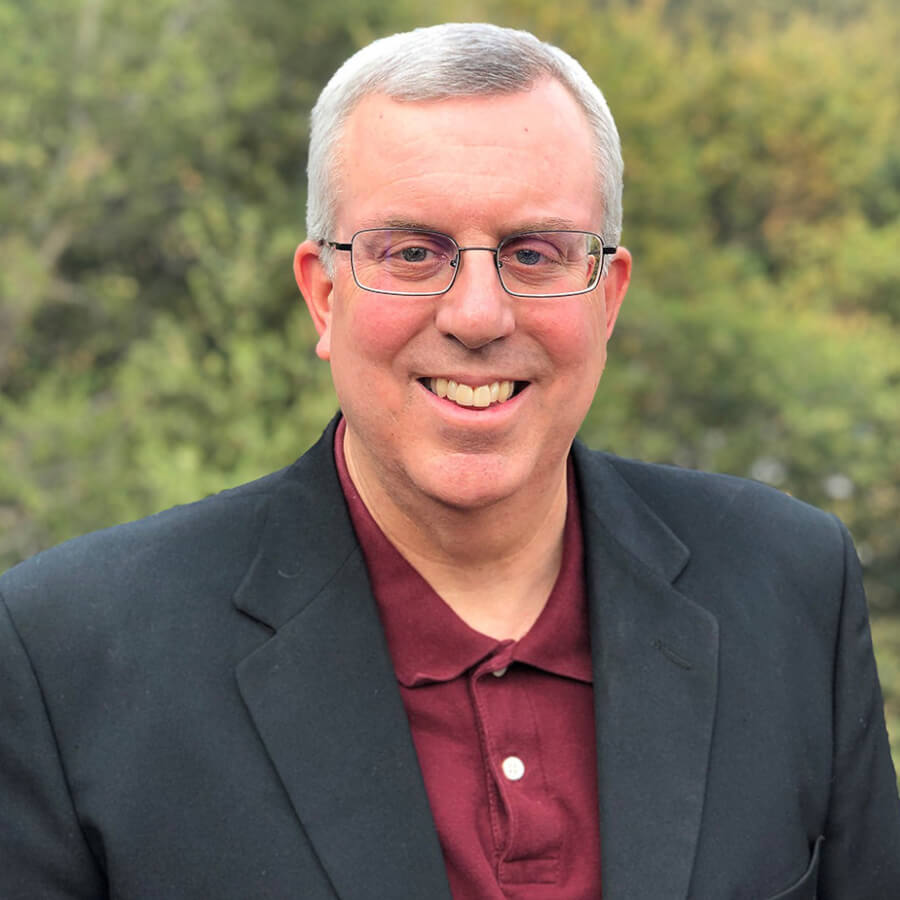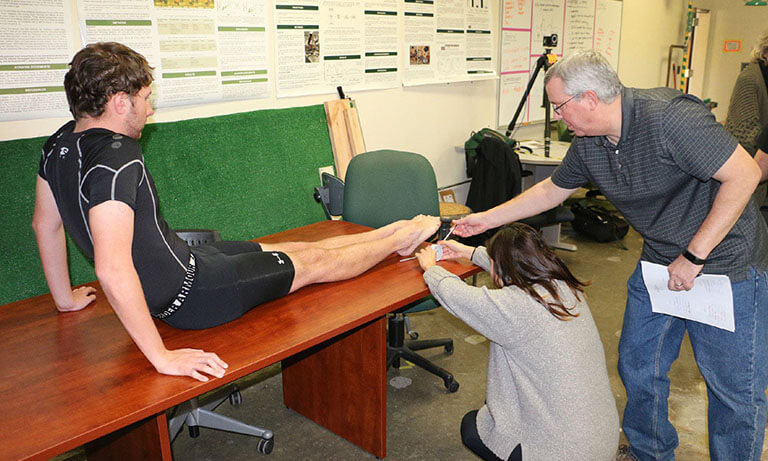As infrared cameras captured the amputees’ movements on exercise bikes, treadmills and elliptical machines, faculty and student researchers were especially interested in how much stress their subjects were placing on their knees, hip joints and cartilage.
“One of the biggest challenges is how to integrate human-made materials that can be quite stiff with living, less-stiff biological tissues that have various responses to the objects they are interacting with,” said Scott Hazelwood, a biomedical engineering professor and one of a team of faculty members who lead the Cal Poly Human Motion Biomechanics Laboratory. “The main contribution of my students and myself on these projects was to use the information gathered from the motion analysis experiments to generate whole knee computational models to examine the buildup of pressure on the cartilage on the knee — and, therefore, the risk of arthritis — throughout the motions of these exercises.”
Hazelwood, who was one of three Cal Poly faculty members to receive the university’s 2019-20 Distinguished Scholarship Award, has looked at the effects of aging, exercise, obesity, injury and disease on the growth, remodeling and degradation processes of bone and cartilage. He has researched the biomechanics of amputees, overweight individuals, marathon runners and more.

“Our findings, combined with the work of many other researchers in this field, may be useful to drug companies as they continue to develop improved treatment methods for osteoporosis,” Hazelwood said. “The work we have done with amputees and overweight and obese individuals may be useful in designing fitness-sustaining exercise programs that prevent the onset of arthritis or help in the rehabilitation of those with arthritis. For marathon runners, our work may help in developing a training program aimed at reducing bone fatigue.”
Clara Lin, a graduate student from Palo Alto, California, who is seek a master’s in biomedical engineering, helped study the impact on femurs that runners sustain in training and running these 26.2 mile events.
“I learned that females experience different loads than males while running, which increases bone damage and may contribute to their higher likelihood of developing stress fractures,” said Lin, who earned her undergraduate degree at Cal Poly.
Predicting Bones
Hazelwood’s doctorate work involved developing a computational model to predict how bones react to prosthetics. Much of his research over his career has specifically involved internal prosthetics, such as hip and knee replacements.
“Not only may the body have an adverse reaction to the metal, plastic or ceramic materials introduced to it, but the response of the bone tissue may be to resorb away, possibly resulting in loosening of the implant or bone fracture,” he said.
Hazelwood is a regular at the Human Motion Biomechanics Lab, along with mechanical engineering faculty Steven Klisch and Brian Self, Britta Berg-Johansen, a biomedical engineering lecturer, along with kinesiology lecturer Christie O’Hara. The lab’s research team is interdisciplinary, and involves students and faculty from the Mechanical and Biomedical Engineering Departments, the Kinesiology and Statistics Departments in the College of Science and Mathematics, and the Food Science and Nutrition Department in the College of Agriculture, Food and Environmental Sciences.
Featuring 12 motion capture cameras, the lab conducts biomechanical analyses of human motion with a focus on estimating joint loads and motion.
Students working with Hazelwood, both in and beyond the lab, have had an opportunity to conduct research that can help others. The amputee study, for example, was assisted by a U.S. Department of Defense grant to help amputees plan their exercise habits, movements and exertion to prevent future surgery or injury.
Canine Care
Even during the pandemic, recent graduate Tayler Kastlunger, of San Diego, was able to perform relevant research for her thesis project, working with Hazelwood on simulation software to test a full-body prosthetic prototype for a dog born with a congenital limb deformity.
“I used finite element analysis to analyze the maximum stresses experienced on the prosthetic under different loads experienced during the gait of a canine,” said Kastlunger, who last June earned a master’s degree in biomedical engineering with a concentration in mechanical design. “Performing finite element analysis identified the weak points in my project where fatigue or failure could occur with repeated loading.”
Like Kastlunger, Lin said her research with Hazelwood has helped develop skills she will need in the biomedical engineering profession.
“I think my research experience will help me with my future career because it challenged me to design a study, think critically, and clearly present results,” said Lin, who plans to graduate in June and looks forward to working with medical devices in the future.


